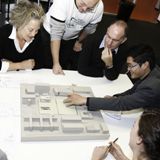
 An innovative new post-graduate course aimed at integrating low-carbon engineering solutions into architectural designs is now being offered at UNSW.
An innovative new post-graduate course aimed at integrating low-carbon engineering solutions into architectural designs is now being offered at UNSW.
Funded by the NSW Office of Environment and Heritage as part of its Energy Efficiency Training Program, the Integrated Design Studio for High Performance Buildings brings together students from the Faculties of Engineering and the Built Environment to work in teams to design low-carbon, energy efficient buildings.
Course convenor, Professor Deo Prasad, says the new Integrated Design Studio course is testing how an “integrated design approach can deliver the highest performance in green buildings”.
“We are encouraging students from different disciplines to begin collaborating and to bring their perspectives together early in the design process, so that engineering solutions can be built into a more optimised design, rather than added as an afterthought,” he says.
Prasad, who is also Director of the CRC for Low-Carbon Living, says the course tries to “push the bar for performance in green buildings, in terms of energy, water usage and waste – the critical indicators in terms of energy efficiency”. He is one of a team of leading cross-Faculty academics and industry experts who either helped to facilitate, or contribute guest lectures, to the course, including A/Prof Alistair Sproul, Dr Paul Osmond, Graham Bell and local eminent architect Tone Wheeler.
Dan Nguyen and Jacqui Salter, both Masters students from the Faculty of the Built Environment, have completed the course, and worked in a team with architecture and engineering students.
The student teams were required to redesign the Materials Science building at UNSW. The building is outdated and has been designed for a different era, so it doesn’t meet the space and use requirements of the high-tech research that is being conducted inside. Jaqcui, who works part-time for a government-housing agency, says sustainable development is becoming increasingly important for people at the lower end of the socio-economic scale, particularly as energy prices continue to increase.
“The urban environment is important for everyone, but it’s made increasingly complex with the economy and pricing. That’s why sustainable development is so important for those at the lower end of the scale,” she says.
Dan Nguyen hopes to take concepts learned in the course back to his home in Vietnam.
“It’s a developing nation, so it could greatly benefit from the integrated design concepts, to produce affordable, efficient housing”, he explained.
The students received excellent feedback and were lucky to have so many experts attend and critique their final design presentations, which were held last Sunday 27 May, including expert architectural critic, columnist and author, Dr Elizabeth Farrelly amongst others.
The students say the design project wasn’t without its difficulties.
“Architects seem to be more concerned about form, for example, and engineers are worried about how things will work. But working in teams turned this inside out, in a way. It’s been a fantastic experience”, Nguyen concluded.

Dr Paul Osmond (course facilitator, FBE) Rory Toomey (panel critic, Environa Studio - behind) Francoise Burgun (Visiting Fellow, School of Photovoltaics & Renewable Energy, or SPREE)

Tom Dwyer (GSOE9122 student, ‘Byg Ideas’ team) Dr Elizabeth Farrelly (panel critic, columnist, author & urban consultant) Tone Wheeler (course facilitator & architect/director, Environa Studio) A/Prof Alistair Sproul (course convenor and facilitator, SPREE) Paulo Sembrano (SUSD0007 student, ‘Byg Ideas’ team) Rebecca Smith (ARCH9006 student, ‘Byg Ideas’ team) James King (GSOE9122 student, ‘Byg Ideas’ team).
